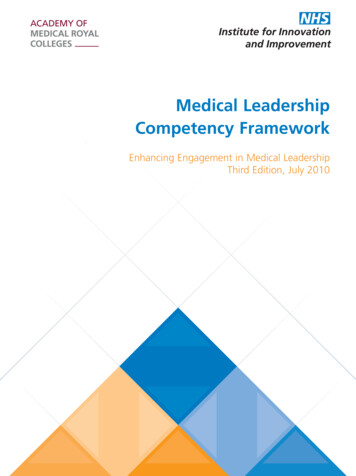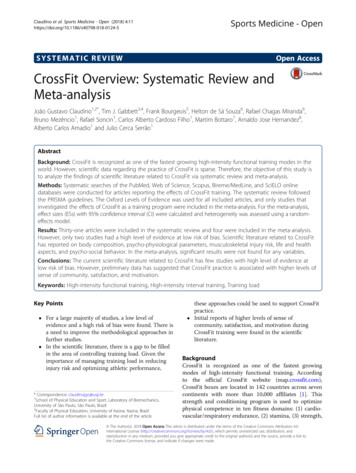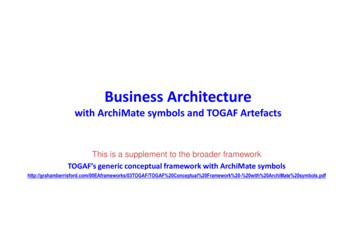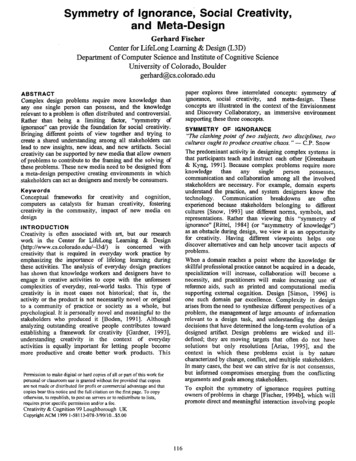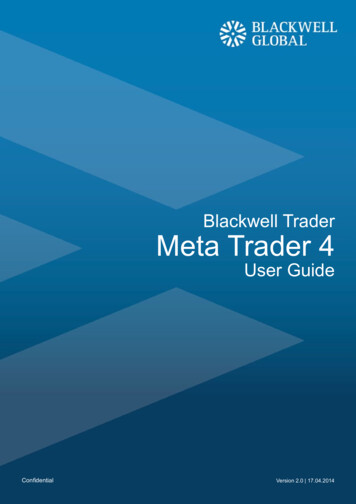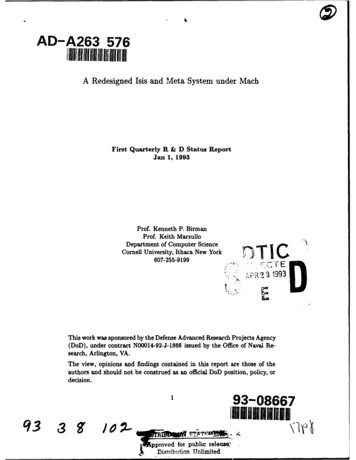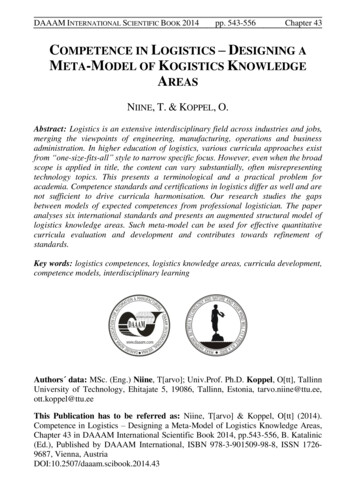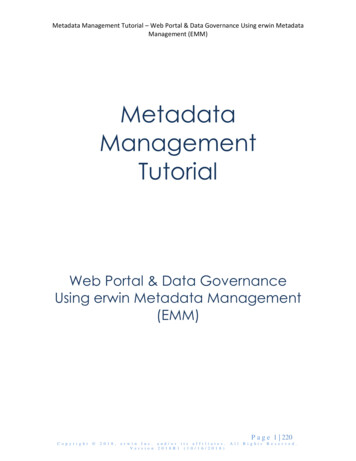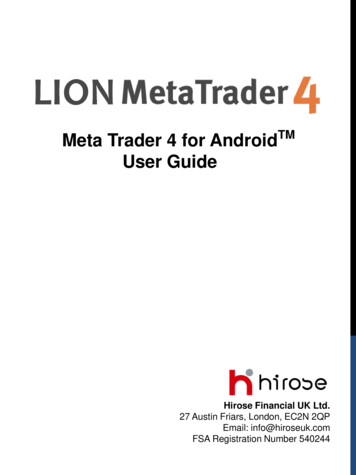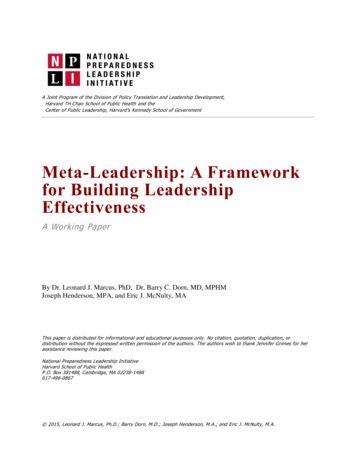
Transcription
A Joint Program of the Division of Policy Translation and Leadership Development,Harvard TH Chan School of Public Health and theCenter of Public Leadership, Harvard’s Kennedy School of GovernmentMeta-Leadership: A Frameworkfor Building LeadershipEffectivenessA Working PaperBy Dr. Leonard J. Marcus, PhD, Dr. Barry C. Dorn, MD, MPHMJoseph Henderson, MPA, and Eric J. McNulty, MAThis paper is distributed for informational and educational purposes only. No citation, quotation, duplication, ordistribution without the expressed written permission of the authors. The authors wish to thank Jennifer Grimes for herassistance reviewing this paper.National Preparedness Leadership InitiativeHarvard School of Public HealthP.O. Box 381488, Cambridge, MA 02238-1488617-496-0867 2015, Leonard J. Marcus, Ph.D.; Barry Dorn, M.D.; Joseph Henderson, M.A.; and Eric J. McNulty, M.A.
Meta-Leadership2Meta-Leadership:A Framework for Building Leadership EffectivenessAbstractLarge organizations and the work they accomplish are becoming less hierarchical and morereliant on complex and inter-dependent connections with other entities. Leading in such anenvironment requires expanded thinking and activity beyond one’s formal bounds of authority.Meta-leadership is a theoretically robust and pragmatically useful evidence-based framework andpractice method for generating widespread influence and cohesive action that expands theleader’s domain of engagement, leverage, and efficacy. 2015, The President and Fellows of Harvard University
Meta-Leadership3Meta-leadership: IntroductionLarge organizations in the 21st century have emerged as global enterprises marked by delayered management structures, diverse workforces, dynamic and ubiquitous informationsystems, complex supply chains, strategic alliances, and outsourced resources. Thesesignificantly expand the scope of responsibility and complexity of leadership. The speed andfrequency of change are increasing. Opportunities to source and sell are global. So, too, arethreats, be they market moves, competitor shifts, terrorist networks, or natural disasters. It is nolonger simply a matter of leading within a well-defined hierarchy: It is now necessary to exerciseleadership across a network of entities with “interactive, interdependent, and creative processes”(Prati, Douglas, Ferris, Ammeter, & Buckley, 2003) – both within and outside of one’s ownagency or firm. Within the organization, flat or matrix structures have increased the complexityof accountability, control, and the exercise of power and influence, so adoption ofnonhierarchical leadership models has risen in importance and demand (Meisel & Fearon, 1999).For the first time in the U.S, four generations are working at the same time (Hankin, 2005), eachwith different expectations and norms for leader and follower behavior and motivation(Hackman & Johnson, 2004). Simultaneously, work has moved from industrial to knowledgebased endeavors that require different organizational constructs and protocols. Confronted withthese challenges, leaders cannot afford to lead in traditional ways (Green, 2007). Beyond the fourwalls, the locus of function, be it production or action, often occurs at the nexus of relationshipsamong a variety of parties that contribute to the function (Schilling, 2001). The transformation ofthe traditional organization requires the transformation of the traditional leader (Ashkenas,Ulrich, Jick, Kerr, 2002).In this environment, one’s formal position is but one component of leadership capacity. Amore accurate definition and measure of leadership is “people follow you.” To achieve this,leaders find themselves challenged to use influence as much as or more than formal authority;authority and accountability structures are more reciprocal and relational (Wagner, 2008).Organizational boundaries function as semi-permeable membranes rather than hard walls withthe involvement of other internal and external entities. Such organizations are often complex,networked, emotional, and chaotic (Green, 2007). 2015, The President and Fellows of Harvard University
Meta-Leadership4The complexities of structures demanding non-stratified leadership are often obscured bythe focus of traditional theories that presuppose that leadership is a top-down leader-subordinateconstruct, typical of hierarchical organizations (e.g. Weber, 1905; Lewin, Lippitt, & White,1939; Likert, 1967; Tannenbaum & Schmidt, 1973; Burns, 1978; Bass, 1985). Ancona andBackman (2010) found that approximately 85% of the existing leadership literature assumed ahierarchical leadership structure. Yukl (2002) argued that many leadership theories dealt with asingle level of processes because it is difficult to develop a multi-level theory. Multi-level reality,we argue, is what many leaders face and thus constitutes the impetus for our work. Though thetraditional boss-to-employee relationship has been formalized in clear roles, authority structure,rules, job descriptions, and responsibilities that prescribe performance and productivityexpectations (Fernandez, 1991), many relationships critical to leadership success are not sostructured (Hackman & Johnson, 2000). Theories of matrix organizations often look at crossfunctional relationships within a single organization (Thomas & D’Annunzio, 2005). Thisresearch is valuable but insufficient for addressing the multiplicity of complex challenges that aleader faces today.Figure One: Meta-LeadershipThese theories also do not fully capture what occurs when leaders must catalyze actionwell above and beyond their formal lines of decision-making and control: for example, in leadingthe launch of a new global brand, a major merger or acquisition, or a crisis response that involvesmultiple jurisdictions and government coordination with the private and non-profit sectors. Weargue that the best evidence of effective leadership in these situations is unified commitmentamong all stakeholders toward a common goal – which we call “connectivity.” To achieve this,leaders today must simultaneously lead down in the traditional sense, up to influence the peopleor organizations to which they are accountable, across to activate peer groups and others withintheir organization with whom there is no formal subordinate relationship, and beyond to entitiesoutside of the leader’s organization or chain of command. We describe such broadly envisioned,integrated and overarching leadership as “meta-leadership” (Marcus, Dorn, & Henderson, 2006;Marcus, Dorn, Ashkenazi, Henderson, & McNulty, 2012). Meta-leadership addresses leadershipchallenges that cross inter- and intra-organizational boundaries as well as those that are foundwithin hierarchical structures. This paper explores how meta-leadership integrates a wide rangeof leadership scholarship and maps critical interdependencies when these theories and concepts 2015, The President and Fellows of Harvard University
Meta-Leadership5are applied in complex situations and systems.The Model of Meta-Leadership: Origins and ExtensionsThe meta-leadership model has been developed by observing and analyzing the actions ofleaders in unprecedented crisis situations – post-Hurricane Katrina, during the early phases of theH1N1 outbreak and Deep Water Horizon oil spill, the Boston Marathon bombings response, andother incidents – as well as mergers, acquisitions, and restructurings primarily in the health carefield. Field research was integrated with understanding from the scholarly literature referencedthroughout this paper. We have presented meta-leadership in diverse executive educationalsettings: training more than 650 senior U.S. government, private, and non-profit sector leaders atHarvard University and tracking the impact of their work over a multi-year period; presenting thecommunity-based “Meta-Leadership Summit for Preparedness” program that together engaged5,000 government, private and non-profit sector leaders in 36 cities across the United States(Sobelson et al, 2013); and working with corporations, as by instructing more than 300executives in crisis meta-leadership, management, and communication methods at one globalfirm through a multi-year program. As the principles of meta-leadership have been developedand applied in a variety of situations, the observations are presented here as qualitative ratherthan quantitative analysis in accordance with recommendations for exploratory research through“progressive focusing” (Schutt, 2015; Benbasat, Goldstein, & Mead, 1987).The people we observed most closely were most often working in large, complexorganizations with thousands of employees, highly structured management systems, and multiplestakeholders. These were individuals from the public, private and non-profit sectors. The crisissituations brought the leadership challenges and accomplishments into high relief although theyare equally applicable to complex challenges in non-crisis settings.The majority of our work has been with large public sector agencies ideal for thisanalysis as they are perceived to exhibit many of the characteristics of traditional bureaucraticorganizations – including confining silo-oriented behaviors – while also needing to demonstrateconnectivity across and beyond organizational and sector boundaries to achieve their objectives.When one examines the criticism of the U.S. government after the attacks of 9/11, the attentionis largely focused on the inability of the various intelligence and law enforcement agencies to 2015, The President and Fellows of Harvard University
Meta-Leadership6coordinate their efforts (Kean et al., 2004). When one looks at the response to Hurricane Katrina,the failure of federal, state, and local agencies to act cooperatively and collaboratively has aprominent role in the tragedy (Davis et al, 2006). These failures of rigidly hierarchicalorganization structures underscore the need for incorporation of more flexible, adaptive, andintegrative styles.It is reasonable to ask whether these situations are analogous to the challenges faced byleaders of organizations in other sectors and if the lessons learned are relevant. We believe that,in leadership terms, they are. Certainly public sector agencies lack market-based pressures andare subject to civil service requirements in personnel policy and compensation, and they havegreater political oversight; however:-The foundational elements of understanding individuals and accurately diagnosing asituation are not dependent upon organization type or style; neither are the channels ofconnectivity – up, down, across, and beyond;-All organizations face their own highly fluid, emotionally charged situations – sometimescrises and other times opportunities – that involve stakeholders beyond their directcontrol. The difference between effective and non-effective leadership of the responsecan be measured in share price and sales volume in the for-profit sector and in reputationand engagement across all sectors;-Public, private, and non-profit organizations have become less hierarchical and moreteam-based and thus the need for leadership through influence has increased (Conger,1998);-Public and non-profit sector agency leaders are increasingly expected to attend toefficiency and financial concerns—i.e. behave “like a business.”Meta-leadership has its greatest impact in situations with high stakes and a high numberof stakeholders. Scale, scope, and complexity are perspectives not generally addressed intheories primarily examining mission, motivation, or power structure such as transactional vs.transformational leaders (Burns, 1978; Bass, 1990).The prefix “meta” is likened to its use in “meta-research,” which systematically identifiescross-cutting themes found in many different studies, or “meta-analysis,” which likewisecombines and synthesizes findings about a range of questions in search of overarching thinking 2015, The President and Fellows of Harvard University
Meta-Leadershipand conclusion. Meta-leadership connects what have otherwise been disparate areas of inquiryabout leadership into a cohesive, interdependent framework. It is also likened to its use in“metamorphosis.” Not only must the leader catalyze change, viewing evolution as an activerather than a passive process, but must build and maintain a capacity for intentional leadership –able to remain proactive in the midst of circumstances that can otherwise be overwhelming.Output vs. Input and ThroughputMuch of the leadership literature looks at its topic as a set of characteristics or traits ofindividuals. This is a focus on input to build individual competencies. Another subset examinesleadership as a process. It presents a discussion and an analysis of throughput described asbehaviors, relationships, and incentives (Bolden, Hawkins, Gosling & Taylor, 2011). We arguethat output, the “product” of leadership, is as important as input and throughput. Meta-leadersseek to achieve results that cannot be accomplished by one organization, unit, or department –typically their own – in isolation. The objective can be as diverse as streamlining the supplychain, coordinating the work of different entities during a crisis, integrating health care services,or entering an emerging market, each of which demand change or accommodation bystakeholders outside the leader’s direct line of authority. The responses to incidents we havestudied—including Super Storm Sandy and the Ebola outbreak—have involved multiple publicagencies at the federal, state, and local level as well as entities in the private and non-profitsectors. In situations such as these, poor leadership can lead to serious negative outcomesincluding loss of life. Output matters.Broad, consequential objectives both appeal to and require participation by people whowork in entirely different sectors, organizations, and/or levels of a hierarchical framework. Byintentionally linking the efforts of these numerous actors and many otherwise disconnectedorganizational units, the meta-leader, often operating without direct or explicit authority,leverages and integrates their activities to accomplish something – an output – that would nototherwise be achievable (Schein, 2004). There is value in both the output, the “impact value,” aswell as in the experience of the process, the “collaborative value.” The tangible progress – 2015, The President and Fellows of Harvard University7
Meta-Leadershipimpact – amplifies the experience and rewards of working together – collaboration – and viceversa making the results mutually reinforcing. 2015, The President and Fellows of Harvard University8
Meta-LeadershipThe Dimensions of Meta-Leadership: Design, Concept and PracticeMeta-leadership is not a new theory of leadership; it is a framework that helps organize,integrate, and make more useful relevant insights from the immense volume of leadershipanalysis, practice, and scholarship. The goal is to help leaders effectively navigate complexsituations. Each dimension – Person, Situation and Connectivity – endeavors to encompass abody of research (see Table 1) and to meaningfully integrate the literature.DimensionOne:The PersonTwo:The ychometricanalyses; personaldiscipline; ;stakeholder theory;complexity theory;risk analysis; decisionscience.Organizational leadershipand management; leadingup; followership;influence beyondauthority/powerdynamics; inter- andintra-organizationalrelations; game theory;network theory; boundaryspanning, systems theory.Table 1Connecting the Dimensions of Meta-Leadership to Other Leadership TheoriesAs we have observed adoption of meta-leadership across complex public and privateorganizational systems and networks, we note three important advantages. It provides: 1) aconceptual framework and common vocabulary that describes intentional networking andcohesion within, across and beyond formal organizational boundaries to connect the purposesand work of different stakeholders; 2) a purposeful strategy for action to advance coordinatedplanning and activity; and 3) a compelling mission and rallying cry for both leaders andfollowers that inspires, guides, and instructs, setting a higher standard and expectation forperformance and impact. Meta-leadership guides thinking, decision making, and action toachieve significant, positive, and powerful outcomes.By design, meta-leadership addresses the complexities of generating a unity of actionwhen many different constituencies must be focused into a broadly adopted strategy, plan, or 2015, The President and Fellows of Harvard University9
Meta-Leadership10mission, even if their priorities and proclivities are conflicting (Marcus et al., 2006). In concept,it is a question of best aligning mission, strategy, tactics, and success metrics with the problem oropportunity: What personal and contextual factors affect what meta-leaders perceive, decide, andultimately act upon (Northouse, 2004)? In practice, it is a puzzle of optimally engaging fourfacets of organizational connectivity – up, down, across, and beyond: Who are the manystakeholders that must be influenced and how can they best be leveraged to catalyze mutuallybeneficial forward progress? What other entities should be engaged to create a greaterprobability of success?These broad themes translate into the three dimensions of meta-leadership practice. Thefirst, the Person, represents leadership capacity. The second, an accurate perception of theSituation, constitutes the leadership context. These two are foundational conditions: optimalaction is not possible without them. The third, Connectivity, is the dimension of organizationalor interpersonal capability: leading down in one’s designated formal purview of authority; up tothose to whom one is accountable; across to other departments, units, or teams within theorganization; and beyond to the various entities outside of the organization. The meta-leaderengages in all of the dimensions, variably leveraging each mode of thinking and action as calledfor by circumstances, and always having these different yet complementary perspectives in mind.The intent of the meta-leadership framework and practice method is to draw thesedifferent perspectives into a pragmatic, unified model. The depiction of the dimensions belowdoes not describe or reference all that has been said or could be said on each topic, but ratherarticulates key aspects and their fit into the overall structure.Dimension One: The Person of the Meta-leaderMeta-leaders begin with knowing themselves and the impact they have on others. Ahigh degree of emotional intelligence (Burns, 1978; Salvoney & Mayer, 1990; Goleman, 1996),the ability to process emotional information in order to better navigate the social environment, isone critical characteristic of the person of the meta-leader. People who direct large-scaleoperations or complex initiatives are better able to engage others when they convey theseattributes: self-awareness, self-regulation, motivation, empathy, and social skills. Self-awareness, 2015, The President and Fellows of Harvard University
Meta-Leadership11in particular, has been shown to correlate with leadership effectiveness (Prati et al, 2003; Kerr,Garvin, Heaton, & Boyle, 2005; Tekleab, Sims, Yun, Tesluk, & Cox, 2008). Those with highself-awareness have an understanding of the impact that personality, experience, culture,emotional expression, and character have on others: This is the “who” of the construct(Kirkpatrick & Locke, 1991; Trompenaars, 1994). Self-discipline, drive, understanding, and acapacity to form meaningful and satisfying relationships are critical in the effort to cross theusual divides and boundaries of organizational, professional, and cultural association (Goleman,2001).Whenever one operates outside of one’s formal purview or across clearly drawnboundaries, perceptions of risk to professional status, in-group affiliation, and autonomy mayincrease. Thus meta-leaders must also understand how to build, manage, and maintain trust(Maister, Green, & Galford, 2000). This is particularly true when decisions and actions must betaken without complete information or certainty, such as when operating in a volatile market oran emerging crisis. When people are evaluating whether or not to trust, they weigh factorsrelated to the decision-maker and the situation (Hurley, 2006). The meta-leader understands thisdynamic and strives to take the actions that will achieve the greatest commitment from a widescope of stakeholders, including those outside the formal chain of command. Organizationalcohesion in high-stress situations has been found to be lacking when trust-based relationships areabsent (Kolditz, 2007). In practice, as followers tend to mimic the attitude and behaviors of theleader, when the leader presents a model of composure, balance, and appropriate perspective,followers are calmed and readied for productive activity. Alternatively, agitation, self-centeredcompetition, withdrawal or other polarizing behaviors by the leader will be reflected in groupthinking and action detrimental to overall cohesion.The second critical component is that meta-leaders are willing to filter large, complexproblems through a wide range of possible solutions (Giuliani, 2002). They have abundantcuriosity to imagine that which has not otherwise been discovered (Sternberg, 2006, 2007). Theyview situations as complex, adaptive systems where patterns of connection, dependence, andinterdependence are better sources of understanding system behavior than is a focus on theindividual components or actors. When attempting to exert leadership in such an environment,the leader seeks order beyond control, knowing that he or she cannot regulate all elements of the 2015, The President and Fellows of Harvard University
Meta-Leadership12relevant systems and that attempts to do so are likely to distort and denigrate overall systemfunction (Wheatley, 1999).That the meta-leader has an aptitude for using self- and situational insight for seeing thebigger picture is particularly important in fast-changing, emotionally-charged situations such as aproduct recall, merger, trauma care or crisis response that may send parts of an enterprise intosurvival mode. In any stressful situation, the brain’s response is activated by the amygdala(Cannon, 1929, q.v. Bracha, Ralston, Matsukawa, Williams, & Bracha, 2004), a section of thebrain that triggers the primal survival responses of “freeze, flight, fight.” These responses derivefrom ancient instincts that suppress all other thinking in favor of a narrow range of behaviors thatmaximize the chances of survival (Society for Neuroscience, 1998). We call these the brain’ssurvival circuits. One cannot lead or make decisions effectively when the survival circuits are incontrol; they are the brain’s Emergency Alert System (FCC, n.d.), interrupting regular cognitiveprogramming to transmit urgent threat-avoidance instructions.This reaction has been given many names including the “amygdala hijack” (Goleman,1996) and the “dinosaur brain” (Bernstein & Rozen, 1989). The term we use for this amygdalacontrolled state is going to the emotional basement (Ashkenazi, 2007). The challenge for themeta-leader is to understand that he or she is in the emotional “basement.” and consciously moveup to the middle level of the brain – the routine circuits of learned behaviors, a workroom withtools to continue the building metaphor. Then the meta-leader helps others up to the workroomas well – generally through ingrained routines and responses: the practiced procedures, protocols,or patterns of past experiences that trigger constructive activity and an aura of relative calm(Zander & Zander, 2000; Pillay, 2011). The final ascent is up to strategic thinking in theneocortex or executive circuits. This is the laboratory where complex reasoning and problemsolving occurs. An example of this can be seen in a hospital when a patient suffers a cardiacarrest. After a brief moment of alarm when the amygdala is activated and adrenaline is pumpingfor clinicians, they go into a rote set of well-rehearsed actions. If those routine circuit activitiesdo not resolve the problem, team members will draw on their expertise to develop other optionsfor saving the patient – using the highest level of executive thinking. It takes great selfawareness, stamina, and discipline to control one’s panicked responses in a stressful situationand intentionally elevate one’s mental activity. 2015, The President and Fellows of Harvard University
Meta-LeadershipBeyond the physiology of the brain, many other factors are at play. Subconscious biasesand heuristics shape how an individual perceives and evaluates other people and phenomena(Eagleman, 2011; Kahneman, 2011). They may create blind spots that cause misperception(Banaji & Greenwald, 2013). A wide outlook and curiosity provide the perspective to chart thepossibilities and prompt this vital expansive thinking and action (Heifetz & Linsky, 2002). 2015, The President and Fellows of Harvard University13
Meta-Leadership14Dimension Two: The SituationThe task of diagnosing and communicating the leadership context – what is happening –is among the most difficult yet most critical in any complex situation, time of change, or momentof crisis. Finding the most appropriate solution to a challenge depends first on preciselydetermining what is occurring (Bransford & Stein, 1993; Pretz, Naples, & Sternberg, 2003). Thisinvolves more than simply observing surface phenomena: it requires “tuning in to theorganizational frequency to understand what is going on beneath the surface” (Goffee & Jones,2006).The difficulty is compounded because there is often a gap between objective reality andsubjective assessment (e.g., Hazleton, Cupach, & Canary, 1987). This is why Dimension One,self-knowledge, is so important to Dimension Two. In practice, the meta-leader must grasp, workwith, and narrow the likely reality-belief gap, aided by the collection of further information, thepassage of time, and the perspective of hindsight. Such complex circumstances demand thecapacities and skills for strategic “situational awareness” (e.g., O'Brien & O'Hare, 2007), theconnectivity between the personal capacities and understandings embedded in meta-leadershipDimension One and the realities of the situation that are addressed in Dimension Two.This gap is further magnified when many different stakeholders are involved, when agreat deal of information is required to diagnose the problem, when the stakes and emotions arehigh, or when the analysis and action are time-constrained. In other words, the greater thecomplexity, the more difficult it is to develop an evidence-based, clear, and actionabledescription of what is occurring and thus develop the most appropriate response. Getting as closeas possible to objective reality and conveying it accurately to others is at the heart of DimensionTwo.Especially in stressful times of change, challenge, or crisis, there can be difficulties ininformation flow between organizational units, competition among hierarchies, and priorities thatare in conflict. The meta-leader can be caught in the cross-fire. In a complex situation, the manystakeholders involved naturally each have their own analysis and interpretation of the “objectiveproblem” in accordance with their distinct interests, concerns, and purposes (Australian PublicService Commission, 2007). The meta-leader also understands that each stakeholder uses adistinct frame, or mental model (Senge, 1994), built of values, experience, objectives, and 2015, The President and Fellows of Harvard University
Meta-Leadership15priorities. This filters what is seen and how risk is perceived. Success and failure may bemeasured differently by different stakeholders (Daly & Watkins, 2006), yet the leader must makedecisions and take action. These unique frames tend to be hard to for others to see, are oftenperceived as complete by the framer but rarely are so, and are difficult to adjust (Clyman, 2003).The meta-leader looks for ways in which the differences can complement rather than contradictone another. The intent is to understand and to integrate the divergent perspectives into a morecohesive view that incorporates what is happening with the identified interests, potentialcontributions, and objections of each stakeholder, and to characterize both gaps and overlaps inactivity. To move stakeholders toward coherence and clarity, the meta-leader draws upon thecapacities outlined in Dimension One, distinguishing which priorities are most important to theoverall endeavor and calculating both the potential upsides and downsides of each option for thedifferent stakeholders. These calculations are then used to chart a course forward. With thisgreater understanding, the meta-leader can begin to craft a compelling and mutually agreeablegoal that fosters unity of purpose and effort.The meta-leader recognizes that the size of the gap between perception and reality willshift and hopefully diminish over time. In practice, the anticipation of additional and moreaccurate information and the expectation that the situation will remain fluid for some time doesnot relieve the meta-leader of responsibility: It puts even more pressure upon a leader to assesswhen there is enough information and when there has been enough debate to move to action.This is an iterative process of divergence and convergence with concrete intermittent points ofagreement (Roberto, 2005). Herein one finds both the tension and the paradox of DimensionTwo: In a complex situation, a quick assessment that is close to the mark and moves the processforward is better than a slow though more accurate one that comes too late to make a difference,though there are risks as
Meta-leadership is a theoretically robust and pragmatically useful evidence-based framework and practice method for generating widespread influence and cohesive action that expands t

